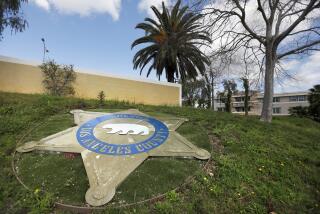Influential sex therapist and researcher
Marilyn Fithian, an influential sex therapist and researcher known for her studies on nudity and sexual dysfunction, died Sept. 11 at Long Beach Community Hospital. She was 87.
The cause was complications of pneumonia, according to her granddaughter, Michelle Todd.
With colleague and longtime companion William E. Hartman, Fithian founded the Center for Marital and Sexual Studies in Long Beach, where they conducted research and treated people with sexual problems. They wrote a well-regarded text for sex therapists, “Treatment of Sexual Dysfunction” (1972), that is often cited for its down-to-earth approach and detailed explanation of therapeutic techniques.
She and Hartman, who died in 1997, were sometimes described as the Masters and Johnson of the West Coast, whose contributions to their field were considered as important as those of Alfred Kinsey and the team of William Masters and Virginia Johnson.
“They helped legitimize and destigmatize sex research,” said professor Eli Coleman, a past president of the Society for the Scientific Study of Sexuality and director of the human sexuality program at the University of Minnesota. He described their book on sexual dysfunction as one of the most important in the field during the 1970s, along with Masters and Johnson’s landmark work “Human Sexual Response.”
Fithian and Hartman were prodigious researchers, who gathered data on the sexual performance of 751 subjects -- 282 men and 469 women. “To date that is the largest number of subjects ever studied in human sexual response research,” sex historian Vern Bullough wrote in his 1994 book “Human Sexuality: An Encyclopedia.”
According to Bullough, they compiled 10,000 hours worth of observations over two decades and monitored some subjects as many as 20 times. The prowess of some of their male subjects inspired “Any Man Can,” their 1984 book about multiple male orgasms.
Watching sexual acts hour after hour was not as exciting as others might presume. “Sex research,” Fithian often said, “is boring.”
Fithian, who was born Sept. 7, 1921, in Wasco, Ore., said she knew early in life that she wanted to be a sex researcher but did not pursue it until after the last of her four children entered school. In 1958, she enrolled at Cal State Long Beach, where one of her first projects was a cross-cultural study of prostitution, and earned a bachelor’s degree in sociology in 1962.
Three years later she received a master’s degree from Cal State L.A. and became a licensed marriage and family counselor.
Her master’s thesis was based on research about nudism that she conducted with Hartman, who had been one of her professors at Long Beach. They interviewed 2,600 people at 150 nudist camps around the country over eight years and in 1970 published their survey, “Nudist Society,” which found that those who chose clothing-free environments were generally well-educated and married.
As she told Robert A. Georges and Michael Owen Jones in their book “People Studying People,” she reluctantly disrobed before interviewing nudists and was immediately identified as a “cottontail,” or non-nudist, because of telltale tan lines.
In 1968, she and Hartman opened the Center for Marital and Sexual Studies. They trained scores of sex therapists, including more than 50 male-female therapy teams, and gave seminars around the country.
Their practice focused mainly on heterosexual couples and often incorporated group therapy. They also worked with disabled people and, according to Bullough, were the first sex therapists to use surrogates to treat single women who were unhappy in their sex lives.
“In all those situations, Marilyn was the lead therapist,” said Ted McIlvenna, president of the Institute for Advanced Study of Human Sexuality in San Francisco, where Fithian received her doctorate in 1992 and taught courses.
Describing Fithian as an unusually warm and caring person, he said she was “the grandmother of clinical sexology in the United States.”
She is survived by four children, seven grandchildren and eight great-grandchildren.
Her practice was not conducted solely in the clinic. She and Hartman held desert retreats, which often began with a stop at the Hadley Fruit Orchards store in Cabazon. They used the emporium’s vast display of dried produce -- particularly the dates, nuts and figs that were “reminiscent of early sexual symbols” -- to launch a free and open discussion of sex. This was Fithian’s idea, inspired by her studies in mythology, which she taught at Cal State Long Beach along with courses in marriage and family counseling.
She and Hartman both divorced their spouses and lived together for 27 years. According to Todd, when they were in their 70s they decided to get married, but Hartman died before the ceremony could be held. Fithian wore her wedding dress to his funeral.
--
More to Read
Start your day right
Sign up for Essential California for news, features and recommendations from the L.A. Times and beyond in your inbox six days a week.
You may occasionally receive promotional content from the Los Angeles Times.







